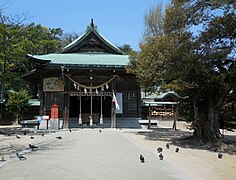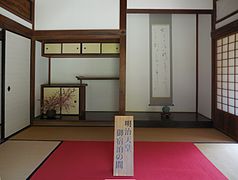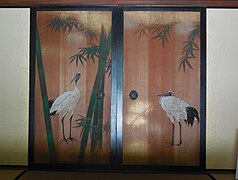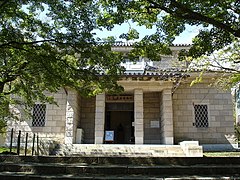Chofu (Shimonoseki)
|
Chōfu ( 長 府 ) district of Shimonoseki |
|
|---|---|
| Coordinates | 33 ° 59 ′ 56 " N , 130 ° 59 ′ 27" E |
| surface | 17.63 km² |
| Residents | 29,761 (Dec. 31, 2011) |
| Population density | 1688 inhabitants / km² |
| Incorporation | March 26, 1937 |
Administration address |
1-6, Chōfu-Doinouchichō, Shimonoseki-shi, Yamaguchi 752-0974 |
| structure | |
|
see section city districts |
|
Chōfu ( Japanese 長 府 ) is an old residential city, in which a branch family of the Mōri clan ruled from 1602 to 1868 . Chōfu - now a district of Shimonoseki - still conveys the image of a city inhabited by samurai in some streets. Chōfu prides itself on being the starting point of the Meiji Restoration ( 明治 維新 発 祥 之 地 , Meiji-Ishin Hasshō-no-chi ).
history
Chōfu, actually Chōshū no kokufu ( 長 門 国 府 ), was the capital of Nagato Province (Chōshū) in ancient times . In 1602 it became the seat of the Chōfu fiefdom , a branch of the Chōshū fiefdom , both of which were ruled by the Mōri clan. The city describes itself as Jōkamachi (castle town), but has no castle, as the Mōri were satisfied with a "permanent house" ( 陣 屋 , jin'ya ). The Mōri and their subjects were staunch opponents of the Tokugawa shogunate. It was then Takasugi Shinsaku (1839-1867), who in town a troupe ( 騎兵隊 , Kiheitai ), set up, which with their activities initiated the overthrow of the shogunate.
With the establishment of modern administrative systems, Chōfu was classified as a village parish ( mura ) in Toyoura County on April 1, 1889, upgraded to a small town ( chō ) on April 1, 1911 , but already on March 26, 1937 as a district ( chiku ) of the Shimonoseki municipality slammed, d. H. individual districts of Chofu became districts of Shimonoseki.
Attractions
The Mōri residence, protected by a simple wall, is located on the western edge of the city. It forms a small complex of buildings that includes a garden with a pond. Some sliding doors ( Fusuma ) are painted by Kawabata Gyokushō (1842–1913), a painter from the Nihonga School. One of the rooms indicates that Emperor Meiji stayed there.
The Imi-no-Miya Shrine ( 忌 宮 神社 ) dates back to 193 when it was founded by the legendary Emperor Chūai and the Empress. It has been known by its current name since the Heian period. In the extensive complex there are shrines for the temple founders and other venerated people.
The Kōzan-ji is a temple complex on the northern edge of the city, the main hall of which from 1320 is the earliest example of Zen architecture in Japan. It is registered as a national treasure.
The Chōfu Museum ( 長 府 博物館 , Chōfu Hakubutsukan ), next to the Kōzan-ji, is a local museum of the city of Shimonoseki. Starting with the cultural exchange with Korea, the museum shows the Middle Ages, the modern times, of course taking into account the Mōri rule and the Bakumatsu period and then the present using objects and documents.
Streets, in which the structure of the samurai estate has been preserved, can be found along the river Dangu ( 壇 具 der), which meanders through the city, at cross streets like Furue-kōji or Yokomakura-kōji . Behind the yellow mud walls are modern houses today, but they are still the quiet streets of the Edo period.
Districts
The district of Chōfu ( 長 府 地区 , Chōfu chiki ) consists of the following districts:
- Chidorigaokachō ( 千 鳥 ヶ 丘 町 )
- Chōfu-An'yōji ( 長 府 安 養 寺 )
- Chōfu-Doinouchichō ( 長 府 土 居 の 内 町 )
- Chōfu-Egemachi ( 長 府 江 下町 )
- Chōfu-Furueshōjichō ( 長 府 古 江 小路 町 )
- Chōfu-Hagoromochō ( 長 府 羽衣 町 )
- Chōfu-Hagoromo-minamimachi ( 長 府 羽衣 南 町 )
- Chōfu-Hamaurachō ( 長 府 浜 浦 町 )
- Chōfu-Hamaura-minamimachi ( 長 府 浜 浦南 町 )
- Chōfu-Hamaura-nishimachi ( 長 府 浜 浦西 町 )
- Chōfu-Higashisamuraimachi ( 長 府 東 侍 町 )
- Chōfu-Hinodechō ( 長 府 日 の 出 町 )
- Chōfu-Hōjōchō ( 長 府 豊 城 町 )
- Chōfu-Innaichō ( 長 府 印 内 町 )
- Chōfu-Kamenokō ( 長 府 亀 の 甲 )
- Chōfu-Kanayachō ( 長 府 金屋 町 )
- Chōfu-Kanayahamachō ( 長 府 金屋 浜 町 )
- Chōfu-Kawabata ( 長 府 川端 )
- Chōfu-Kojōchō ( 長 府 古城 町 )
- Chōfu-Kon'yachō ( 長 府 紺 屋 町 )
- Chōfu-Kuromonchō ( 長 府 黒 門 町 )
- Chōfu-Kuromon-higashimachi ( 長 府 黒 門 東 町 )
- Chōfu-Kuromon-minamimachi ( 長 府 黒 門 南 町 )
- Chōfu-Maeyahatachō ( 長 府 前 八 幡 町 )
- Chōfu-Manjuchō ( 長 府 満 珠 町 )
- Chōfu-Manjushinmachi ( 長 府 満 珠 新 町 )
- Chōfu-Matsubarachō ( 長 府 松原 町 )
- Chōfu-Matsuoda-higashimachi ( 長 府 松 小 田東 町 )
- Chōfu-Matsuoda-honmachi ( 長 府 松 小田 本 町 )
- Chōfu-Matsuoda-kitamachi ( 長 府 松 小田 北 町 )
- Chōfu-Matsuoda-minamimachi ( 長 府 松 小田 南 町 )
- Chōfu-Matsuoda-nakamachi ( 長 府 松 小田 中 町 )
- Chōfu-Matsuoda-nishimachi ( 長 府 松 小田 西 町 )
- Chōfu-Minaminochō ( 長 府 南 之 町 )
- Chōfu-Minatomachi ( 長 府 港 町 )
- Chōfu-Mishimachō ( 長 府 三島 町 )
- Chōfu-Miyanouchichō ( 長 府 宮 の 内 町 )
- Chōfu-Miyazakichō ( 長 府 宮 崎 町 )
- Chōfu-Mukaidachō ( 長 府 向 田 町 )
- Chōfu-Nakadoi-honmachi ( 長 府中 土 居 本 町 )
- Chōfu-Nakadoi-kitamachi ( 長 府中 土 居 北 町 )
- Chōfu-Nakahamachō ( 長 府中 浜 町 )
- Chōfu-Nakanochō ( 長 府中 之 町 )
- Chōfu-Nakaochō ( 長 府中 尾 町 )
- Chōfu-Nakaroppachō ( 長 府中 六 波 町 )
- Chōfu-Nogurumechō ( 長 府 野 久留 米 町 )
- Chōfu-Ōgimachi ( 長 府 扇 町 )
- Chōfu-Ōsakachō ( 長 府 逢 坂 町 )
- Chōfu-Saigawa ( 長 府 才 川 )
- Chōfu-Samuraimachi ( 長 府 侍 町 )
- Chōfu-Shinmatsubarachō ( 長 府 新 松原 町 )
- Chōfu-Shinshiōjichō ( 長 府 新 四 王 司 町 )
- Chōfu-Shiōjichō ( 長 府 四 王 司 町 )
- Chōfu-Sotourachō ( 長 府外 浦 町 )
- Chōfu-Sōshamachi ( 長 府 惣 社 町 )
- Chōfu-Takabachō ( 長 府 高 場 町 )
- Chōfu-Tamanourachō ( 長 府 珠 の 浦 町 )
- Chōfu-Toyorachō ( 長 府 豊 浦 町 )
- Chōfu-Yahatachō ( 長 府 八 幡 町 )
- Maeda ( 前 田 )
- Tanahata ( 高 畑 )
- Yume Town ( ゆ め タ ウ ン )
photos
Remarks
- ↑ The current facility probably dates from the early Meiji period.
- ↑ Listed in the source as Maedachō ( 前 田 町 ). However, the postal code directory for Shimonoseki , from which the readings were taken, as well as the official topographic map use Maeda.
literature
- Chōfu Kankō Kyōkai (ed.): Chōfu Sampo (leaflet about the place). 2012.
- Jōkamachi Chōfu Keikan Kyōgkai (Ed.): Chōfu Dobei Annai (Guide to the Walls of Samurai Estate) 2013.
- Chōfu Hakubutsukan (Ed.): Chōfu Hakubutsukan .
Web links
Individual evidence
- ↑ Watertalk Vol. 34. お 住 ま い の 地区 の 検 針 月 . Shimonoseki, December 2010, accessed May 7, 2014 (Japanese).







